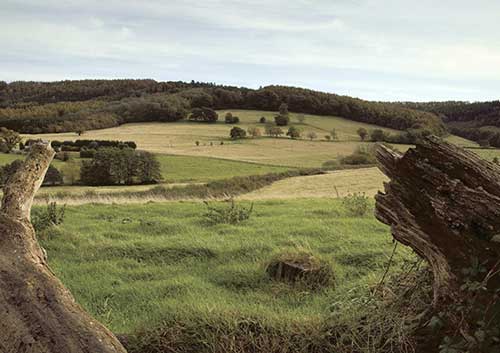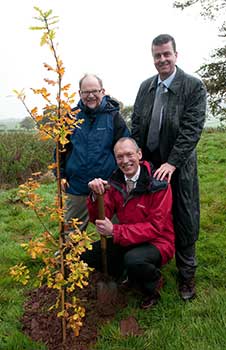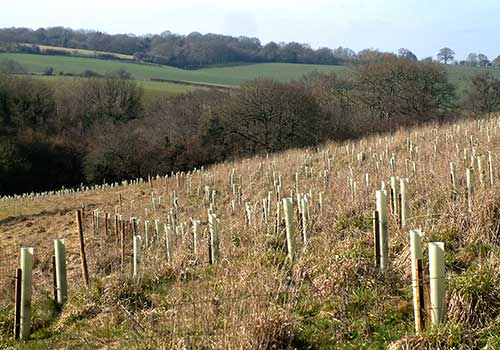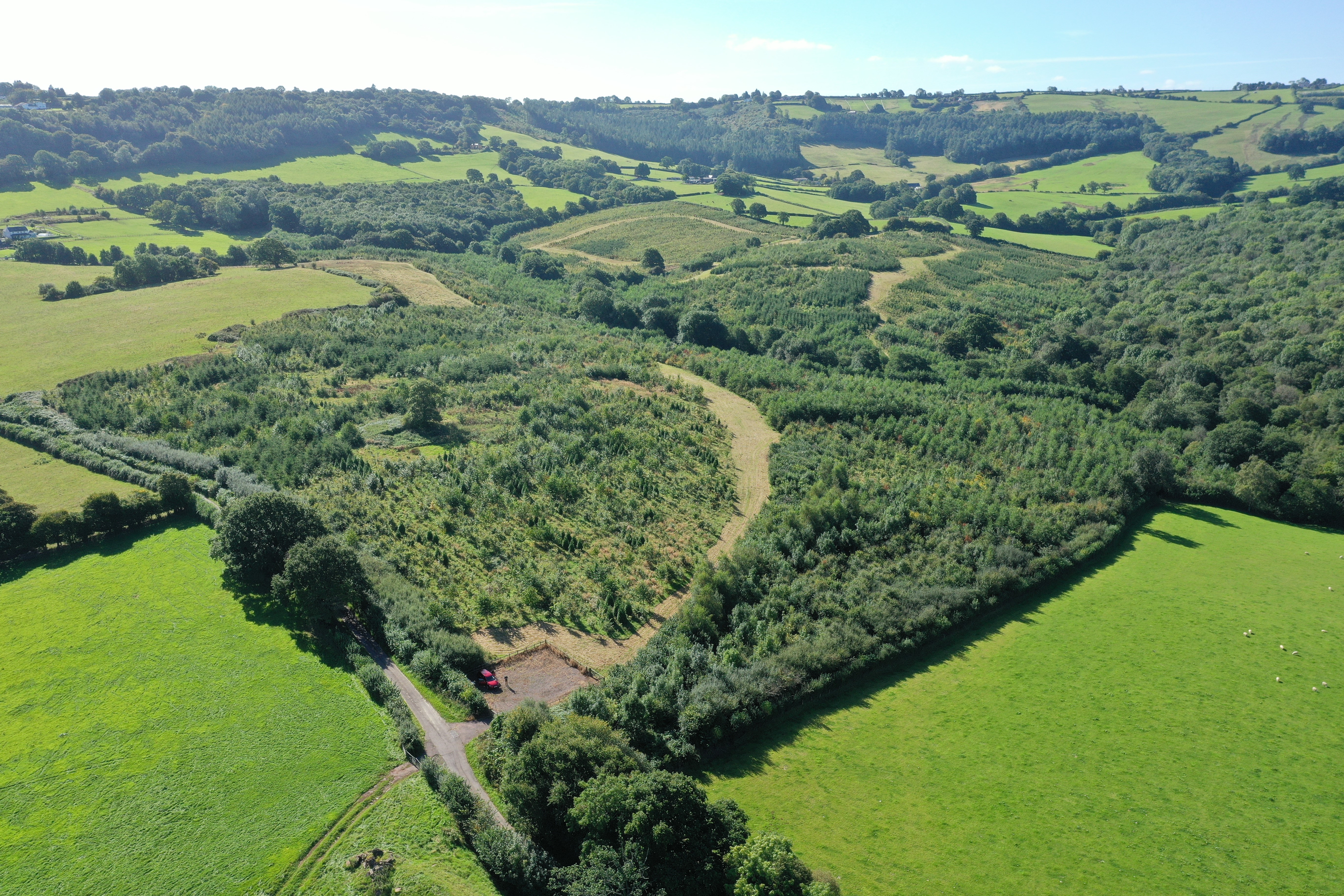Cwm Fagor
Summary
About the site
Carbon Buyers - Why buy from this project?
Landowners - Why get involved in the WCC?
Who is involved?
How we go about it
Wider benefits
Summary
Unique ID: 103000000004447
Status: Verified
Project Developer: Pryor & Rickett Silviculture
Location: Devauden, Monmouthshire, Wales
Previous Land Use: Improved grassland and semi-improved pasture
New woodland area: Gross area: 29.2 ha, Net area: 29.2ha, Open ground: 0ha
Species Mix: Oak 29.1%, Ash 37.0%, Alder 5.2%, Douglas Fir 22.5% Red Cedar 6.2%
Woodland Management: Minimum-intervention in some stands and high quality timber production in others
Estimated Sequestration: 15,387 tCO2e over 100 years
Start Date: 01/01/2009
About the site
Cwm Fagor is about a mile from Devauden in Monmouthshire, close to the Wye Valley AONB. We searched for an area that would be improved by creating a wood so there are no statutory land designations on this existing grassland which is classified as improved or semi improved, having been grazed for many years. The whole site is about 80 hectares and these 29 hectares are the first part to be planted. The whole wood is planted on rolling fields that slope south and west which are bisected by streams. The wood will provide great wildlife and walking links between three isolated Ancient Semi-Natural Woodlands. We estimate that it will take 15 to 20 years complete the whole project.
 View across the site at Cwm Fagor, in 2011
View across the site at Cwm Fagor, in 2011
Carbon buyers - Why buy from this project?
This site is owned by Thorlux Lighting, who will use the carbon credits generated to compensate for the emissions generated by their company activities, as well as providing customers the opportunity to compensate for their lighting-based CO2 emissions.
Landowners - Why get involved in the WCC?
Thorlux Lighting, who owns the site, wants these new woods to be used by people. Thorlux hope that they will come to Cwm Fagor and learn something about wildlife but also about how companies that emit greenhouse gases in their work processes can do something to help reduce their impacts on the climate and natural environment. A broad aim of the project is not only to mitigate the emissions generated by the Thorlux’s activities, but also to provide an opportunity for their customers to commit to capturing their own lighting based CO2 emissions through this project. Thorlux's vision is to make a native wood over 15 to 20 years that is capable not only of capturing carbon dioxide, but that will also provide some quality timber for use in industry in the long term. We have restricted planting in the first 5 years to between 4 and 6 hectares per year, with a view to planting of the whole holding, which extends to some 80 hectares, over 20 years.
Who is involved?
Pryor & Rickett Silviculture is the project developer, on behalf Thorlux Lighting, who purchased the site in order to create a woodland.
Mike Allcock said he was delighted that Thorlux Lighting’s new woodland at Cwm Fagor was the first to be accredited to the Woodland Carbon Code in Wales. “It’s particularly pleasing that this woodland will be contributing towards a number of targets to address climate change. The scheme is a demonstration that we recognise the emissions from Thorlux Lighting and the FW Thorpe Lighting Group and will also help the Welsh Government’s target to increase the area of woodland.
“Our manufacturing processes will always produce emissions and these can be calculated and offset. However, lighting generally accounts for approximately 20% of all global CO2 emissions. We hope to help reduce this level by selling extremely efficient lighting and electronic control systems. Often we can save in excess of 75% of the electrical load on a project, however no matter how much we save, a small amount of energy use is inevitable. By opening our scheme to our customers we are enabling them to purchase tree plantings to offset the emissions generated by them using our products. We do however insist that our customers only choose a very energy efficient lighting from our range as this will make immediate energy savings; woodland offsetting is a long term project."
“Investing in our woodland offers them the chance to do the right thing in partnership with a company committed to the environment, and we hope too that the added credibility of Government support will further encourage customers to join our environmental initiative.”

Welsh Government Minister John Owen Jones plants a tree with Mike Allcock, Thorlux Lighting Ltd, in 2011
How did we go about it?
We consulted all the neighbours bordering Cwm Fagor early on because the development of woodlands and tree cover over time would, if carried out unsympathetically, reduce their personal enjoyment of views over the Usk Valley. We left several areas unplanted, which will provide a useful permanent open space as habitat and for recreational use, as well as maintaining the long-term vistas for our neighbours. We have used some conifers in the mix taking advantage their quicker growth and ability to nurse other slower growing trees but in the main it will look like the other ancient semi natural woods in the area. We will make sure that all the trees are weeded, replaced if they die and pruned whilst they establish. As the young woodland develops we will be keeping a watchful eye on deer, rabbits and squirrel populations so that they don’t harm the growing trees. Every 5 years we are going to monitor the amount of carbon captured by the woodland using Method B of the Carbon Assessment Protocols. We expect that the forest managers will be able to do this monitoring. The Forestry Commission's models predict that the first 29.2 hectares will capture about 15,387 tCO2e over 100 years. As most of the stands will be taken on over a longer time frame to establish a mature, high forest over the whole area, we will make sure that we carry out timely forest management so that long term carbon dioxide capture and retention is at its best. This should allow us to produce high quality timbers capable of replacing ‘carbon-heavy’ building products.
 New planting at Cwm Fagor in 2011
New planting at Cwm Fagor in 2011
What are the wider benefits?
Wider Landscape
Cwm Fagor is a multi-phase, 80 hectare project aiming to connect three isolated Ancient and Semi-Natural woodlands.
Scores (out of 5) for the wider benefits provided by Cwm Fagor. Scores calculated using the WCC Woodland Benefits Tool.
Biodiversity
This project creates the opportunity for the natural spread of isolated ecological communities. We expect that woodland birdlife will increase and that the woodland edge habitats will benefit wildlife generally.
Water
The new woodland will prevent pollution from fertilisers previously used to improve areas of grassland. These improvements to water quality will in turn help to make the streams and riverside zones more diverse in wildlife.
Community
The small pockets of semi-improved grassland we identified will be maintained as open habitat, and the wide ride infrastructure will allow access for walkers to enjoy the woodland as time goes by.
Economy
We will be managing the whole woodland sympathetically, with partial and successive coppicing of the alder along the stream sides.

Cwm Fagor Woodland Progress 2022.


